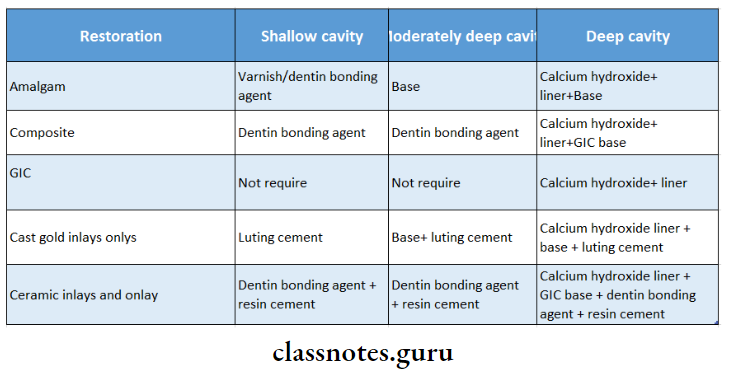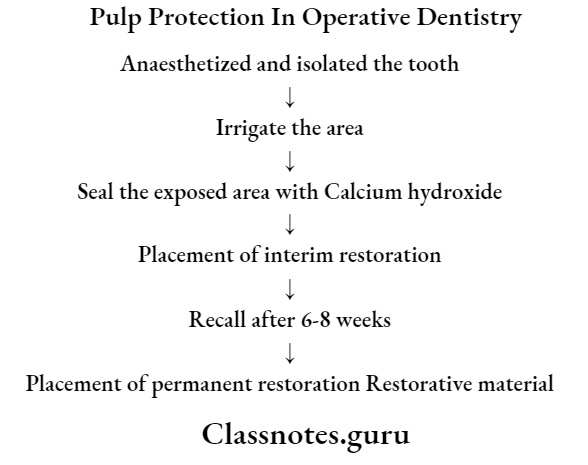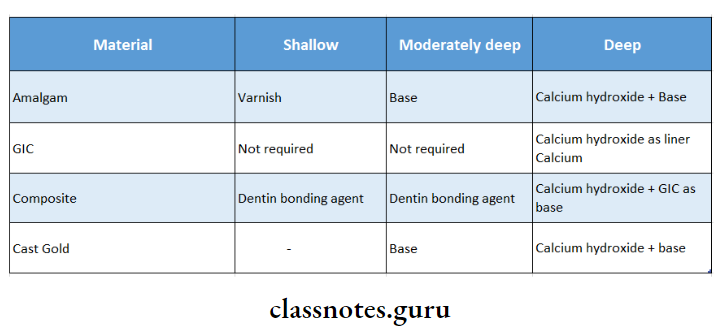Pulp Protection Important Notes
1. Methods Of Pulp Protection

2. Effect Of Remaining Dentinal Thickness On Pulp

3. Classification Of Pulp Protective Agents
- Cavity Sealers
- Varnishes
- Resin bonding agents
- Cavity Liners
- Calcium hydroxide
- GIC
- Cavity Bases
- Zinc phosphate
- Zinc polycarboxylate
- GIC
4. MTA (Mineral Trioxide Aggregate)
- It was developed by Torabinejad et al in 1993
- Used as a direct pulp capping agent
- Composed of tricalcium silicate, dicalcium silicate and traces of magnesium oxide, sodium sulphate and potas¬sium sulphate
- Bismuth oxide is added for radiopacity
Pulp Protection Short Essays
Question 1. Management of shallow and deep carious.
Answer:
Management Of Shallow And Deep Carious:
1. Shallow Caries:
Excavation of caries
↓
Application of liner over the axial and pulpal wall
↓
Placement of base
↓
Permanent restoration
2. Deep Caries:
Indirect Pulp Capping:

Direct Pulp Capping:

Read And Learn More: Operative Dentistry Short And Long Essay Question And Answers
Question 2. Methods of protecting the pulp.
Answer:
Methods Of Protecting The Pulp:
Depends on the use of restorative material and the depth of the cavity

Question 3. Zinc Phosphate.
Answer:
Zinc Phosphate:
High strength base
Zinc Phosphate Composition
- Powder
- Zinc oxide – 90.2%
- Magnesium oxide – 8.2% Water – 36%
- Other oxides – 0.2%
- Silica – 1.4%
- Liquid
- Phosphoric acid – 38.5%
- Aluminium phosphate – 16.2%
- Aluminium – 2.5%
- Zinc – 7.1%
Zinc Phosphate Manipulation:
- Powder/liquid ratio – 1.4 g/0.5 ml
- Dispense on a cool dry glass slab
- Mix using a stainless steel cement spatula in a circular motion
- Mixing time: Each increment – 15-20 sec, total – 1 min.
Zinc Phosphate Uses:
- Luting cement, bases
- Intermediate restorations, root canal restorations
Question 4. Cement Bases.
Answer:
Cement Bases:
A layer of cement placed beneath permanent restoration
Cement Bases Types:
- High strength – Thermal protection
- Low strength – Chemical protection
Cement Bases Properties:
- Thermal fracture or distortion
Cement Bases Examples:
- Zinc phosphate
- GIC
- Calcium hydroxide
Pulp Protection Short Answers
Question 1. Varnish.
(or)
Give composition and objectives of varnishes.
Answer:
Varnish:
- Varnish is an organic copal or resin gum suspended in solutions of ether or chloroform
Varnish Composition
- Solid- Copal resin
- Solvent- Ether, acetone, alcohol
Varnish Action:
- On application, it evaporates leaving behind a protective Film
Varnish Advantages:
- Improves sealing ability of amalgam
- Reduces post-operative sensitivity
- Prevents discolouration of tooth
Varnish Indications:
- Pulpal protection
- Sealing of dentinal tubules
- Reduces microleakage
- Protects tooth from chemical irritants
Varnish Contraindications:
- Under composite resin
- UnderGIC
Question 3. Liners.
Answer:
Liners:
- Liners are fluid materials that adapt more readily to all aspects of a tooth
- Creates uniform, even surface
- Aids in the adaptation of materials such as amalgam
- Has poor strength so cannot be used alone
Liners Indications:
- Pulpal protection
- Formation of reparative dentin
Liners Materials Used:
- ZOE
- Calcium hydroxide
- Flowable composites
- GIC
Pulp Protection Viva Voce
- GV Black simply classified cavities as one class of pit and fissure and four classes of smooth surface caries
- Cavities that occur exclusively in posterior teeth are class 2 cavities
- Cavities that occur both in anterior and posterior teeth are class 1 and 6
- A cavity preparation which includes both internal and external cavity walls is termed intracoronal preparation
- Enameloplasty is indicated when fissure depth is not more than l/3rd the thickness of enamel
- The class 5 cavity preparation is convex mesiodistally
- Cavities of the cusp tips of posterior teeth are class 6 cavities
- The axial wall is the base of class 3 preparation.
